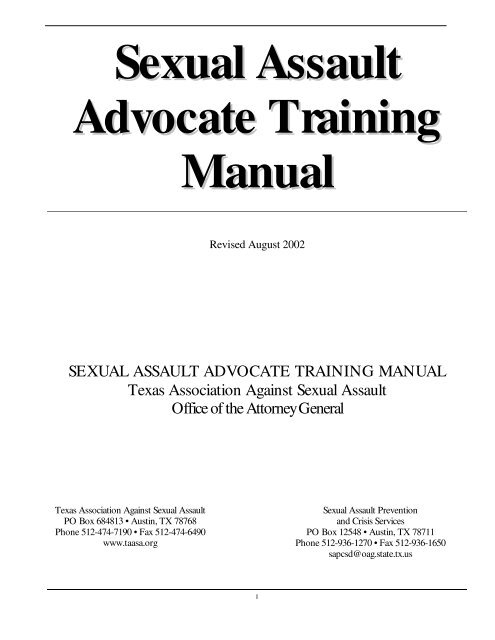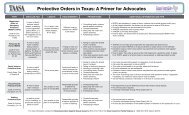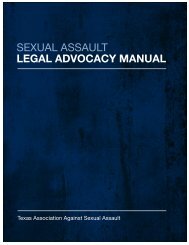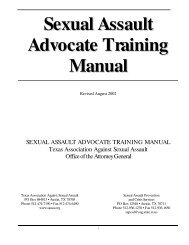Sexual Assault Advocate Training Manual - Texas Association ...
Sexual Assault Advocate Training Manual - Texas Association ...
Sexual Assault Advocate Training Manual - Texas Association ...
You also want an ePaper? Increase the reach of your titles
YUMPU automatically turns print PDFs into web optimized ePapers that Google loves.
<strong>Sexual</strong> <strong>Assault</strong><br />
<strong>Advocate</strong> <strong>Training</strong><br />
<strong>Manual</strong><br />
Revised August 2002<br />
SEXUAL ASSAULT ADVOCATE TRAINING MANUAL<br />
<strong>Texas</strong> <strong>Association</strong> Against <strong>Sexual</strong> <strong>Assault</strong><br />
Office of the Attorney General<br />
<strong>Texas</strong> <strong>Association</strong> Against <strong>Sexual</strong> <strong>Assault</strong><br />
PO Box 684813 • Austin, TX 78768<br />
Phone 512-474-7190 • Fax 512-474-6490<br />
www.taasa.org<br />
<strong>Sexual</strong> <strong>Assault</strong> Prevention<br />
and Crisis Services<br />
PO Box 12548 • Austin, TX 78711<br />
Phone 512-936-1270 • Fax 512-936-1650<br />
sapcsd@oag.state.tx.us<br />
I
Table of Cont ent s<br />
CON TRIBU TORS<br />
I<br />
S E C T I O N 1 1<br />
B A C K G R O U N D<br />
H e r stor ic a l Pe r spe c tive 1<br />
Mythology 5<br />
Soc ia liza t ion 1 0<br />
S E C T I O N 2 1 5<br />
S U R V I V O R P R O F I L E S<br />
Sur vivor St or ie s 1 6<br />
S E C T I O N 3 2 6<br />
O F F E N D E R P R O F I L E S<br />
Child Mole ste r s & Pe dophile s 2 6<br />
Ra pists 3 0<br />
Juve nile Offe nde r s 3 2<br />
S E C T I O N 4 3 5<br />
A D V O C A C Y<br />
Ethic s 3 5<br />
Post Tr a uma tic Str e ss Disor de r 4 1<br />
Ra pe Tr a uma Syndr ome 4 6<br />
Cr isis I nte r ve nt ion 4 8<br />
Suic ide 6 3<br />
Signific a nt Othe r s 7 2<br />
S E C T I O N 5 7 6<br />
S Y S T E M R E S P O N S E<br />
Me dic a l Pr ot oc ol 7 7<br />
La w Enfor c e me nt 9 5<br />
Thir d Pa r ty Re por ting 9 6<br />
Pse udonym 9 9<br />
Cr ime V ic tims’ Compe nsa tion 1 0 2<br />
Cr imina l Just ic e Syste m 1 0 5<br />
S E C T I O N 6 1 1 4<br />
S P E C I A L P O P U L A T I O N S<br />
Childr e n 1 1 4<br />
Adole sc e nts 1 1 9<br />
Adults Mole ste d As C hildr e n 1 2 3<br />
Se nior s 1 3 0<br />
Ma le Sur vivor s 1 3 6<br />
Pe ople of Color 1 4 1<br />
Pe ople w ith D isa bilitie s 1 4 5<br />
Ga y/Le sbia n Sur vivor s 1 5 6<br />
S E C T I O N 7 1 5 9<br />
C A T E G O R I E S O F S E X U A L A B U S E<br />
Ac qua inta nc e /Da te Ra pe 1 5 9<br />
Ma r ita l Ra pe 1 6 8<br />
Se xua l H a r a ssme nt 1 7 1<br />
Sta lking 1 7 4<br />
Substa nc e -Re la te d Se xua l Abuse 1 7 8<br />
Ritua l Abuse 1 8 3<br />
Se xua l Exploita tion by H e lping<br />
Pr ofe ssiona ls 1 8 6<br />
S E C T I O N 8 1 9 0<br />
S P E C I A L C O N C E R N S<br />
Spir it ua l Issue s for Sur vivor s 1 9 0<br />
Da nge r s of Confr onta tiona l Advic e 1 9 4<br />
Polygr a ph a s a Supe r vision Tool 2 0 2<br />
Civil Suit Re me die s 2 0 4<br />
STIs/H e pa t itis 2 0 6<br />
H IV/AIDS 2 1 6<br />
S E C T I O N 9 2 1 9<br />
T H E A D V O C A T E<br />
Se c onda r y Vic t imiza tion 2 1 9<br />
Str e ss & Bur nout 2 2 3<br />
S E C T I O N 1 0 2 2 7<br />
S E L F P R O T E C T I O N /R I S K R E D U C T I O N<br />
Se lf-Pr ote c tion 2 2 7<br />
S E C T I O N 1 1 2 5 4<br />
R E F E R E N C E S<br />
An Intr oduc tion to Role Pla y 2 5 4<br />
Cr ime V ic tims’ Rights 2 5 9<br />
Te xa s Pe na l Code 2 6 5<br />
Pe ople of Color 2 8 0<br />
Pr ost itut ion a nd Se x Wor k 3 0 1<br />
Pr e gna nc y 3 1 0<br />
Me dic a l Pr ot oc ol 3 1 3<br />
I
S E X U A L A S S A U L T A D V O C A T E T R A I N I N G M A N U A L<br />
Section<br />
S E L F - P R O T E C T O N /<br />
R I S K R E D U C T I O N<br />
SELF-PROTECTION/<br />
RISK REDUCTION<br />
S<br />
exual violence can include several kinds of crimes; rape, incest, sexual<br />
harassment, child molestation, marital rape, exposure and voyeurism.<br />
Ninety percent of all rapes are planned and in 87 percent of the cases<br />
the assailant either carried a weapon or threatened the victim with death or<br />
bodily injury if he/ she resisted.<br />
Self-Prot ec t ion<br />
W<br />
hen speaking of self-protection, we must consider these facts:<br />
• <strong>Sexual</strong> assaults are going to happen. An offender who wants to commit<br />
rape, eventually will find a victim.<br />
• Many sexual assaults are unavoidable. Regardless of previous training<br />
and preparation, some people will face situations where the rape is<br />
going to occur.<br />
• Rape victims DO NOT share any responsibility of the crime with the<br />
offender. The offender is 100 percent responsible for the rape.<br />
With these facts in mind, self-protection can be viewed in three areas:<br />
• Preventing the assault<br />
• Escaping the assault<br />
• Surviving the assault<br />
227
S E X U A L A S S A U L T A D V O C A T E T R A I N I N G M A N U A L<br />
ASSERTIVE COMMUNICATION<br />
Knowing your rights and standing up for them may prevent you from being<br />
sexually assaulted. Everyone has the right to set his/ her own standards for<br />
sexual behavior and to resist pressure when those standards are violated. Do<br />
not apply pressure on others to live up to (or down to) labels like: stud, foxy,<br />
dude, wimp, frigid, whore, easy, prude, etc. It is not fair to give up your own<br />
ideas, standards and needs just to be nice or to be liked by others. Know your<br />
rights and do not apologize!<br />
This requires relatively honest, clear and open communication between the<br />
sexes and we must begin with men and women talking to each other more<br />
frankly about sex, personal needs and limits. Everyone needs to begin rejecting<br />
stereotypes that teach men to regard women only as sex objects and women to<br />
see men as protectors and free rides. Equalize relationships - take turns being<br />
in charge of things, and be ASSERTIVE without being aggressive.<br />
Communicate expectations by asking (do not guess) what your dates’ or<br />
friends’ desires are. Have ideas about the evening and communicate them<br />
clearly, verbally and non-verbally (body language). Be direct and do not hint.<br />
Express your ideas ("I think", "I feel", "I want"). Do not attack or put down<br />
("the trouble with you is..."). Know your rights and do not apologize ("Gee,<br />
I’m really sorry but..."). Speak clearly and directly (do not giggle, squirm, smile<br />
a lot or whisper).<br />
To be assertive means to express your ideas and needs clearly, to enforce your<br />
rights without violating someone else’s, to disagree with others without putting<br />
them down personally, and to be direct and to speak up for yourself. An<br />
assertive statement is an honest expression of feelings, needs and rights said in<br />
your own words, a way of working out differences and having more honesty<br />
with others. The idea is not to win, but to work things out.<br />
Make and declare your choices about sex - what you will and will not do, what<br />
you expect from others, and say "yes" if you mean yes, "no" if you mean no,<br />
and know the difference.<br />
Men need to know that women do not think money buys them and that<br />
dressing sensually does not mean that they want to have sex, and that, even if<br />
she has had sex with him previously, she may choose not to do so again. For<br />
some women, it is hard to be direct because they do not want to hurt the<br />
man’s feelings. Women may enjoy sexual contact without sexual intercoursefriendship<br />
with a man may or may not include sexual activity. Many women<br />
feel that men want friendship with them only if it includes sex.<br />
228
S E X U A L A S S A U L T A D V O C A T E T R A I N I N G M A N U A L<br />
EDUCATING WOMEN FOR RAPE AVOIDANCE<br />
Commonly Used Styles of Attack (Donna Myhre, July 1982):<br />
❏ BLITZ - This is the stereotypical rape situation in which the woman is<br />
physically attacked suddenly, with no warning. The rapist may literally leap<br />
out of the bushes or an alley, or he may come from nowhere to drag her<br />
into a secluded or isolated area or pull her into a car. A blitz attack also<br />
occasionally happens between acquaintances. This also applies when the<br />
woman is with the rapist without suspecting any danger, and suddenly,<br />
without warning, he becomes violent (this is most likely to happen with an<br />
anger rapist).<br />
❏ BREAKING AND ENTERING - This is a rape situation where the<br />
victim is in her home and the rapist illegally gains entry. If she is asleep at<br />
the time, it will feel like a blitz attack to her. Occasionally such rapes are<br />
committed by burglars who thought no one was home, and upon finding<br />
a woman in the house, decide to rape her. More often, the rapist breaks in<br />
with the intention of raping, though he may also steal some of her<br />
possessions while he is there.<br />
❏ TRAPS - Some rapists will set traps and wait for unsuspecting victims to<br />
walk into them. For example, the rapist who hides in the back seat of an<br />
empty car, in the closet of an empty house, or in the laundry room of an<br />
apartment building.<br />
❏ CON GAMES - Rapists who use this style gain the confidence of the<br />
victim by pretending to be someone they are not (e.g., a police officer, a<br />
salesman, an old friend of the victim’s husband, etc.) or by<br />
misrepresenting his intentions (e.g., offer to help change her flat tire, carry<br />
her groceries, first date, need to use the phone, etc.). After the victim is<br />
off guard and the rapist has gained access to her home or some other<br />
secluded place, he proceeds to threaten and attack her.<br />
❏ TESTING PATTERN - Some rapists go through a process of testing<br />
potential victims. The aim of the testing, from the rapist’s point of view, is<br />
to find out whether the woman can be intimidated that is, will she be an<br />
easy victim. The general pattern of the test can be seen in the stranger on<br />
the street situation. Step one is an innocent remark or request – “Can you<br />
tell me how to get to Main Street?” or “Do you have a light?” or “Nice<br />
weather, isn't it?” Step two is an offensive remark which would not be<br />
offensive coming from someone the woman is close to, but is totally<br />
inappropriate coming from a stranger – “Is your boyfriend/ girlfriend<br />
229
S E X U A L A S S A U L T A D V O C A T E T R A I N I N G M A N U A L<br />
treating you well?” . Step three is a clear threat: “ Come with me or I'll kill<br />
you,” or “ I have a gun in my pocket, keep quiet, or I'll shoot.”<br />
At each step, the rapist is judging whether or not the woman can be<br />
intimidated, whether she appears weak and unsure of herself, whether or not<br />
she will put up a fight or make a fuss. If he thinks she can be intimidated, he<br />
proceeds with the next step.<br />
A variation of the testing pattern is sometimes used in acquaintance rapes. In<br />
this instance the rapist and his intended victim are engaged in casual, innocent<br />
conversation because they know each other perhaps they work together, or go<br />
to school together, or are neighbors. At some point, the rapist steers the<br />
conversation into an intimate and/ or sexual area where his remarks become<br />
inappropriate, given the nature of their relationship. Usually the intended<br />
victim begins feeling uncomfortable, suspecting that something is wrong. The<br />
rapist is waiting to see how she deals with that; if she pretends that nothing is<br />
wrong, if she goes along with this turn of conversation for fear of<br />
embarrassment or whatever, he then proceeds with a threat or with the actual<br />
attack.<br />
Sometimes the con game and the testing pattern are combined.<br />
PRECAUTIONS<br />
Given this background information on risks and rapists, it is time now to<br />
speak of what women and men can do to avoid rape. Rape avoidance measures<br />
can be divided into three (3) different kinds of things women and men can do:<br />
1. Precautionary actions, such as home and car security, those<br />
things which will make it less likely that a rapist will decide to<br />
attack them;<br />
2. Avoidance measures, ways that women can detect and escape<br />
from potentially dangerous situations before the rapist has enough<br />
control of the situation to do serious harm; and<br />
3. Resistance measures, options for the woman who is confronted<br />
by a man intent on raping her, and from whom there is no easy<br />
way out immediately -- that is, the rapist has already gained some<br />
control over the situation.<br />
The basic principle underlying precautionary and security measures is that the<br />
more difficult it is for a rapist to attack a woman, the less likely it is that he<br />
will. There are no guarantees that he will not; it is simply a matter of increasing<br />
the odds in the woman's favor.<br />
230
S E X U A L A S S A U L T A D V O C A T E T R A I N I N G M A N U A L<br />
When advising women on protective measure, it is important to remember the<br />
socio-economic status of the woman. Not everyone has the financial capability<br />
to invest in the best locks, alarms and burglar bars. Encourage women who<br />
have little money to be creative in finding alternative ways to increase their<br />
safety.<br />
Some suggestions rape crisis services have collected from women are: simple<br />
wire coat hangers hanging on doorknobs and window latches are a no-cost<br />
alarm system -- the clatter they make when the door or window is opened can<br />
be quite noisy; brackets on each side of a doorway to hold a broom-handle can<br />
make it much more difficult for anyone to break through the door. Women<br />
who are concerned about security will be able to come up with their own<br />
innovative techniques.<br />
In addition to the security measures, there are other kinds of<br />
precautions which women can take:<br />
cThe less you look like a victim (weak and vulnerable) the less likely you<br />
are to become a victim. Again, there are no guarantees; it is a matter of<br />
increasing the odds in your favor. Learning to walk and talk in a<br />
manner portraying self-confidence can increase your safety. Posture<br />
can make a difference: sitting, standing and walking with your back<br />
straight, your head up, being clearly aware of your surroundings.<br />
cTaking an assertiveness training course can be very helpful; learn to<br />
speak loudly, clearly, firmly; learn how to say "NO" with certainty.<br />
cIn speaking of these things with women, it is not a good idea to talk<br />
about "victim-types." This can cause unnecessary distress for any<br />
woman who has already been victimized, and can also lead some<br />
women who have not been raped to believe they are not victim-types<br />
and therefore have no need for precautions.<br />
It makes more sense to speak of victim behavior, and to acknowledge what<br />
is true that all of us, on occasion, for various reasons, engage in this behavior.<br />
Victim behavior refers to acting in ways that convey helplessness, weakness or<br />
vulnerability.<br />
In this context, explore the idea of women who are physically<br />
challenged.<br />
cWomen who are physically challenged in some way may be more<br />
vulnerable to be attacked by rapists. Physically disabled and develop<br />
mentally disabled women are frequently chosen as victims because<br />
they may be less able to defend themselves.<br />
231
S E X U A L A S S A U L T A D V O C A T E T R A I N I N G M A N U A L<br />
cEveryone can be challenged at certain times in certain ways. Everyone<br />
suffers from temporary handicaps. For example, being asleep is a<br />
temporary handicap. The woman who is awakened from a sound sleep<br />
to find a man standing over her, intent on raping her, faces one of the<br />
most difficult situations imaginable. She has been caught utterly by<br />
surprise, may be groggy and is probably in a prone position.<br />
cWomen who are drunk or drugged may be temporarily challenged.<br />
Their physical capabilities might be slowed down and their judgment<br />
could be impaired. Another common challenge might be depression.<br />
Most people are afflicted by "low days," times when things are not<br />
going well and they are unhappy about their lives. Depression can<br />
impair one’s physical and mental responses as surely as drugs can.<br />
cUndergoing a life disaster may also make one temporarily more<br />
vulnerable to attack. Many women have been raped during the days,<br />
weeks, or months after some other awful event occurred, like having<br />
been in an auto accident, or after the house burned down, or the death<br />
of a family member.<br />
Be aware of how temporary challenges increase our vulnerability and<br />
take extra precautions. Make efforts to appear less vulnerable by<br />
consciously straightening up our posture, speaking assertively, etc.<br />
Also, choose to avoid some temporary handicaps, such as being drunk.<br />
AVOIDANCE MEASURES<br />
Awareness of the high risk of being confronted by a rapist, plus knowledge of<br />
the styles of attack which rapists employ, may help some women avoid some<br />
dangerous situations by escaping from them while escape is still a relatively<br />
easy matter.<br />
If you are walking down the street and there is someone following along<br />
behind you, and you think he might mean harm to you, you can do something<br />
about it. You can cross the street, go to a public place where there are other<br />
people, or go to a pay phone and call for help.<br />
Most women have been taught not to make a scene. This learned fear of not<br />
making a scene can be un-learned and replaced with a greater concern for<br />
safety.<br />
Another problem for many women in such situations is the fear that they are<br />
right, that it is a dangerous situation, and they will be attacked. It is<br />
characteristic of people to we often choose to run away from fear -- not from<br />
the danger which causes the fear, but from the fear itself.<br />
232
S E X U A L A S S A U L T A D V O C A T E T R A I N I N G M A N U A L<br />
Staying with the same example, where you are walking down the street and<br />
become aware that a man is following you. It can be tempting to just ignore<br />
him and hope he will go away, tempting for you to continue as you are in the<br />
hope that if you do nothing to attract attention he will not notice you. It may<br />
also be true that the more a person looks helpless, weak, and scared the more<br />
attractive he/ she might be to rapists.<br />
Research on avoidance has shown that in most cases women who react as<br />
soon as they are aware of danger usually are able to get away from the danger<br />
without any serious damage to themselves, of any kind. The important thing is<br />
taking immediate action of some kind, like running away, making a loud noise,<br />
or whatever may seem appropriate in the situation.<br />
With an awareness of the risks of rape and knowledge of the motivations and<br />
behavior patterns of rapists, plus trust in their own intuition, women can<br />
develop their own built-in early warning systems. Trust your intuition - it is a<br />
real thing, research has confirmed its existence. There is scientific evidence of<br />
the value of women’s intuition.<br />
Your best weapon against rape is an educated intuition. Know as much as you<br />
can, be as aware and alert as you can -- then trust your intuition. It is on your<br />
side. Your intuition works for you, not against you. An alert intuition can help<br />
you avoid situations and places where there could be a rapist waiting to trap<br />
you. Your intuition can help you see through a con game, or detect a rapist’s<br />
testing pattern, early enough to give you the warning you need to escape from<br />
the situation with little or no damage.<br />
When confronted by what seems to be the beginning of a testing pattern,<br />
women can fail the test by not looking or acting like victims. Generally,<br />
assertive behavior, rather than either passive or aggressive behavior, is enough<br />
to steer the rapist away.<br />
The rapist who tests you first is asking the question: "Can this woman be<br />
intimidated?" By the way you act and speak, you can convince him that you<br />
cannot be intimidated. Speak firmly, loudly, clearly; look at him directly. As in<br />
the case of the man who is following you on the street, simply ignoring him is<br />
likely to make you look vulnerable and scared (like an easy victim).<br />
In dealing with a possible rape situation, where the (possible) rapist has not yet<br />
made a clear threat or move to attack, usually being assertive is a better choice<br />
than being either passive or aggressive. Assertive is neither weak (nor hostile)<br />
but is strong, firm and calm.<br />
Children are told not to take candy from strangers, but in fact, adult women<br />
are more likely than children to be attacked by strangers. The candy offered to<br />
233
S E X U A L A S S A U L T A D V O C A T E T R A I N I N G M A N U A L<br />
women may be the offer of a ride home, help getting the bags of groceries<br />
home from the supermarket or changing a flat tire.<br />
Perhaps even more often, the stranger asks the woman for help with<br />
something. It can be difficult to refuse a request for help, especially for women<br />
who have been taught to be helpful. Statistics show that women in the helping<br />
professions are particularly vulnerable to rape because sometimes answering a<br />
request for help can endanger them. Your safest course usually is a polite but<br />
firm refusal.<br />
RESISTANCE MEASURES<br />
It is not always possible to avoid a rape situation. Even women who are well<br />
informed and careful to practice precautionary and avoidance measures can be<br />
caught in a direct confrontation with a rapist. Escaping from the situation,<br />
running away from the rapist, is of course always the first choice, do it if<br />
possible. The exceptions to this are those situations in which it is clear that<br />
fleeing will not be possible no matter what the woman does, such situations<br />
occur, but they are rare.<br />
When speaking of resistance in a rape situation, resistance measures move into<br />
the part of rape avoidance education which has been most confusing in the<br />
past. Women have been told contradictory things about what they should do<br />
when confronted by a rapist. They have been told that any resistance will only<br />
get them killed. They have been told they should fight back. They have been<br />
told to be seductive and win the trust of the rapist in order to get in the right<br />
position to stick their thumbs in his eyes. They have been told to treat him like<br />
a human being so that he will see them as human. They have been told to<br />
"turn him off" by acting crazy or vomiting.<br />
It is time to move beyond this confusing and contradictory advice. There now<br />
exists good research results from four different studies on rape avoidance.<br />
Women can also use some common sense based on all that they know about<br />
rape. It is time to offer women options - not rules.<br />
The research shows that women have tried a number of different strategies in<br />
rape situations. All of these strategies have worked successfully at times. Some<br />
of them work more often than others, and using more than one strategy<br />
greatly increases the chance of success.<br />
Because physical resistance, fighting back, does work more often than other<br />
strategies, and because many women have been taught to be afraid of fighting<br />
back, this manual examines that strategy more than the others. It is important<br />
to remember that there are options, that no one is bound to any one method<br />
of resistance. If you fear facing a rapist, you are the one who must choose<br />
what to do about it. In that situation, you know better than anyone else what<br />
234
S E X U A L A S S A U L T A D V O C A T E T R A I N I N G M A N U A L<br />
your best choice is. Trust your intuitive feelings about what might work best in<br />
that situation, but be ready to try something else next.<br />
235
S E X U A L A S S A U L T A D V O C A T E T R A I N I N G M A N U A L<br />
These are all choices in a rape situation:<br />
• Running away or trying to run away<br />
• Physical resistance, fighting back<br />
• Yelling, screaming, blowing a whistle<br />
• Talking assertively or aggressively<br />
• Crying or pleading<br />
• Conning<br />
• Looking crazy or repulsive<br />
The first four of these options are considered more effective than the last<br />
three, but all of them have worked in some situations. Remember that using<br />
more than one increases your chance of escape. It can be effective to combine<br />
two or more strategies. For example, fighting and yelling at the same time, or<br />
combining assertive talking with a con (e.g., saying loudly and firmly: "You had<br />
better leave now. My brother is a karate expert and I was expecting him to be<br />
here 10 minutes ago").<br />
Elaboration on each of these options will help women understand better how<br />
to use them and can give them more viable choices. Admittedly, those<br />
strategies which are less likely to be effective appear to be the<br />
easiest (for most women) to carry out. But:<br />
cIf you are being subjected to a sexual assault, there is no easy way out.<br />
You are likely to get hurt, emotionally or physically or both, no matter<br />
what you do. It may seem that the easiest course of action is inaction,<br />
doing nothing in the hope that he will only rape you quickly and leave.<br />
It is important to understand that what may seem easiest at the time<br />
will not, in the long run, be easy at all. A woman who resists an<br />
attacker and is not raped will nevertheless experience some trauma<br />
afterward, but it will be less severe than if she had not resisted. In<br />
other words, choose less suffering for yourself.<br />
cDeciding not to resist at all is also no guarantee a victim will not be<br />
physically injured. While active resistance may mean that one will incur<br />
minor physical injuries, more serious physical injuries are usually<br />
intentionally inflicted by a rapist who wants to hurt his victim - and he<br />
will do it anyhow, whether she resists or not, no matter what she does,<br />
unless she can escape from him.<br />
In the past, some rape prevention educators have made a mistake assuming<br />
that women fear physical injury above all else. They have equated hurt with<br />
physical injury and not with emotional damage, and then advised women<br />
on getting out of a rape situation without getting hurt but only raped. The<br />
236
S E X U A L A S S A U L T A D V O C A T E T R A I N I N G M A N U A L<br />
fallacy of assuming that raped is not hurt should be very clear. Now many<br />
must deal with the idea that the hurt of rape is preferable to the hurt of<br />
physical injury, if one has a choice.<br />
It is rare for a rape victim to sustain a physical injury so serious that its effects<br />
last as long as those of her emotional trauma. Many rape victims have said that<br />
they would do anything, including risking serious injury or death, to prevent it<br />
from happening again.<br />
There is a common but mistaken idea that women cannot stand the pain of<br />
physical injury. In fact, women can tolerate pain as well as or better than men.<br />
And there is no way that any woman can decide that she will not get hurt in a<br />
rape situation. The chances are that she will be hurt, no matter what she<br />
chooses to do. What she can do is choose to resist, by whatever strategy or<br />
strategies, and know that she is taking action which will lessen her emotional<br />
trauma.<br />
It cannot be emphasized too strongly that the aim of any strategy will be to<br />
escape from the situation. When speaking of resisting, especially when talking<br />
about fighting back, the goal is winning a fight, or overpowering an attacker. It<br />
is about changing the situation to the extent that escape becomes possible.<br />
That may mean, in various situations, loosening his grip, getting him off<br />
balance, and/ or distracting him or discouraging him (remember that a rapist is<br />
not looking for a fight, but for a victim).<br />
The two strategies which are most often effective, especially if used in<br />
combination with yelling (or otherwise making a loud noise) and physical<br />
resistance.<br />
cSome women like to carry whistles, and that is fine, for a whistle does<br />
have an authoritative sound which will attract attention, cause the<br />
rapist to worry about discovery, and possibly bring aid. But it would be<br />
a mistake to depend on a whistle to save you from rape. It will not. It<br />
may be there when you need it, and it may be effective.<br />
cA loud yell is more reliable. You never have to dig it out of the bottom<br />
of your purse or pocket. But notice the difference between yelling and<br />
screaming; a yell is a loud roaring sound, a scream is higher pitched<br />
and sounds weaker because it carries a feeling of "I am scared." If the<br />
noise you make is more like a yell than a scream, it has a better chance<br />
of being effective. It will also be more effective, and you will have<br />
more confidence in it, if you practice it sometimes. You may have to<br />
be careful about when and where you practice! But most of us have<br />
opportunities in our lives to practice yelling: at football games, calling<br />
the children home, or just when driving along the highway. If you<br />
practice now and then you will know it is there if you need it. Try to<br />
237
S E X U A L A S S A U L T A D V O C A T E T R A I N I N G M A N U A L<br />
make the sound come up from your diaphragm rather than your<br />
throat. You might also practice yelling "NO!" rather than simply<br />
making a noise.<br />
Some people argue against yelling as a strategy on the basis that it may<br />
lead to the rapist trying to "shut up" his intended victim by killing or<br />
seriously injuring her. This is not likely to happen, but does not mean<br />
it will never happen, but only that the odds are against it. This is<br />
especially true if the woman begins yelling as soon as she is<br />
confronted by the rapist. At this point he has not yet committed a<br />
serious crime and his easiest option is simply to leave. If he decides to<br />
stay he probably will threaten the victim with serious consequences if<br />
she does not agree to be quiet. The woman who is being threatened<br />
will have to decide how seriously to take his threats and what her<br />
safest course of action is.<br />
If he is threatening to shut you up, these are things to remember,<br />
consider and feed into your intuition:<br />
bHe means you harm, in any case, no matter what you do.<br />
bIf he says he will not hurt you if you will just be quiet, possibly what<br />
he means is that he will only rape you; he probably does not<br />
understand that rape hurts.<br />
bIt can make a difference whether or not you have reason to believe<br />
that anyone else will hear you yelling and come to your aid.<br />
bIf he is like most rapists, he will not intentionally kill you. He knows<br />
that murder is a crime, and he does not see himself as a criminal. He<br />
may not even realize that what he is doing is rape, or it may be that he<br />
does not think rape is really a crime.<br />
bLet your intuition be your guide. Remember that it is on your side.<br />
Usually your intuitive feeling about the best thing to do will be right.<br />
It is unfortunate that the issue of physical resistance against rape has become<br />
controversial. Women should not be made to feel either that they must fight<br />
back against rapists or that they cannot fight back. Experts are free to take<br />
extreme positions and argue with each other over the question of physical<br />
resistance. Women confronted by rapists do not have that kind of freedom<br />
and they certainly have no time for arguments. Important to give women<br />
accurate information relevant to resistance, rather than dogmatic opinions<br />
about which resistance strategy is the best.<br />
238
S E X U A L A S S A U L T A D V O C A T E T R A I N I N G M A N U A L<br />
In doing research on rape avoidance, different scientists in different parts of<br />
the country interviewed hundreds of women who had been raped and women<br />
who had successfully resisted a rape attack. They found that the most effective<br />
reaction to a sexual assault was to run away. The second most effective<br />
strategy, and the most effective strategy in situations where running away was<br />
not immediately possible, was physical resistance. That does not mean that<br />
fighting back is always the best option. It is still important for the woman to<br />
trust her own intuition and make her own decision in any situation. At the<br />
same time, however, while women must not feel compelled to fight attackers<br />
in every situation, they also should be able to choose physical resistance<br />
without being restricted by mistaken fears about resistance.<br />
Some of the rape prevention education of the past has made women more<br />
afraid of resistance than of rape. Women have been told that if they fight back<br />
they are only asking to get murdered as well, whereas if they would just<br />
passively submit they would only get raped. This mistaken idea has probably<br />
done more harm than any of the other myths about rape. There are some<br />
things we can say now to counteract some of the damage that has been done.<br />
You do not endanger yourself by resisting a rapist. If you are facing a man who<br />
intends to rape you, you are already in danger. You did not create this danger;<br />
he did.<br />
Most rapists are not murderers. As we have already said, most rapists see<br />
murderers as criminals, but do not think of themselves as criminals. They do<br />
not think of rape as a crime, and they do not understand the devastating<br />
effects of rape on their victims.<br />
The majority of rapists are insecure men with weak egos. Their main weapon is<br />
intimidation, and threats which are often bluffs. Many of them can fairly easily<br />
be intimidated.<br />
The rapists who kill intend to kill. They intend to kill before the victim does<br />
anything. They intend to kill regardless of what their intended victims do. They<br />
do not kill in response to their victim’s resistance, but in response to their own<br />
inner urges.<br />
The odds are low for encountering a sadistic (killer) rapist, but it can happen.<br />
Your only chance for survival is escape and your only chance for escape is<br />
some kind of resistance. Your best chance to escape is to try every kind of<br />
resistance strategy that you can. You lose nothing by trying everything you can.<br />
Most women do not know how strong they are, for they do not test their<br />
strength as many men do. Most women are stronger than they realize. Having<br />
and carrying babies, scrubbing floors, carrying laundry around, many of the<br />
239
S E X U A L A S S A U L T A D V O C A T E T R A I N I N G M A N U A L<br />
things that women do in their daily lives develop strength. It is a mistake to<br />
assume that every woman is weaker than every man.<br />
Women have one inherent physical advantage over men, for their bodies are<br />
constructed differently. Female bodies have a lower center of gravity;<br />
therefore, women have better balance. In a struggle between a man and a<br />
woman, it is the man who is more likely to lose his balance.<br />
If you are in immediate danger of being raped, you will naturally have an<br />
intense emotional reaction. Probably you will be feeling strong fear. (If it is<br />
anger instead, that is great!) This intense emotional reaction causes<br />
physiological changes in your body which give you temporary super strength.<br />
If you know it is there, you can use it.<br />
Most women have heard the story about the mother who, when a car rolled<br />
over her small child, simply lifted up the car. That really does happen, and that<br />
is the kind of thing meant when it is said that you will have a temporary super<br />
strength due to intense emotion.<br />
So if you are facing a rapist you will be scared (or angry). But rather than being<br />
paralyzed with panic, you will be exceptionally powerful. This adrenaline<br />
power is probably one of the most important factors in enabling three-fourths<br />
of women confronting rapists to get out of the situation without getting raped<br />
or seriously hurt physically. Another factor which is sometimes in your favor is<br />
the element of surprise. It is on his side in the beginning, for you were not<br />
expecting to be attacked. But he may not be expecting you to resist strongly<br />
and may be caught off guard by immediate resistance.<br />
These are your natural weapons against attackers:<br />
cYour intuition.<br />
cYour physical strength.<br />
cYour better balance.<br />
cYour intelligence.<br />
cYour determination to avoid, or at least minimize, the emotional<br />
trauma of rape.<br />
He is vulnerable. These are his weak points:<br />
bHis insecurity, his weak ego.<br />
bHis lack of commitment to pursuing you as a victim (unless he is a<br />
revenge rapist).<br />
bHis vulnerable physical characteristics: primarily knees and feet, throat<br />
eyes, and fingers.<br />
240
S E X U A L A S S A U L T A D V O C A T E T R A I N I N G M A N U A L<br />
While martial arts training can increase a woman’s chances of avoiding rape,<br />
and women should be encouraged to take such training, it is important to<br />
distinguish between martial arts and self-defense. Martial arts training is helpful<br />
primarily because it increases the woman’s self-confidence and general physical<br />
condition. The specific techniques of martial arts are of lesser value.<br />
Martial arts training can increase your natural strength, quicken your responses<br />
and build up your own confidence in your abilities. But also remember that<br />
martial arts techniques practiced in formal training proceed according to rules<br />
that do not apply in a real rape situation. You may, or may not, be able to use<br />
any of the techniques of the classroom in real life.<br />
If a good self-defense course is available to you, which concentrates on<br />
techniques which are appropriate to countering a real attack, that is one of the<br />
most important things you can do for yourself.<br />
Here are just a few tips on self defense techniques that you can think<br />
about as possibilities for you to use:<br />
• If he is holding onto you tightly, especially if he has his hands on your<br />
throat, you can grab his smaller fingers and bend them back, until they<br />
break, if necessary.<br />
• Generally his groin area, which many people think of as a primary<br />
target, is not a good target for you to aim at. It is too low for your arms<br />
and too high for your legs to attack with much strength, and it is also<br />
the first place he protects, but while he is busy protecting it, you can go<br />
for a more accessible target.<br />
• Knees are exceptionally vulnerable, a swift kick to the knee can be very<br />
effective.<br />
• A jab to his throat or eyes can also be effective.<br />
• Do not forget your teeth and jaw as a powerful weapon.<br />
• If he is holding your arms, to break his hold pull in the direction of his<br />
thumb, that is the weakest part of his grip, where his thumb and<br />
fingers come together.<br />
Self-defense experts stress the value of mental practice. They say that to<br />
practice self-defense mentally can be almost effective as physical practice. It is<br />
suggested that women use their daily lives for practice situations. There are<br />
many opportunities to mentally prepare for an attack. Even imagined instances<br />
can be used to determine a means of escape.<br />
241
S E X U A L A S S A U L T A D V O C A T E T R A I N I N G M A N U A L<br />
Many women worry about this question: What if he has a gun or weapon?<br />
There is a common assumption that, if he has a gun or knife or some other<br />
deadly weapon, all is lost. According to this assumption, there is no way to<br />
fight a weapon without endangering your life. But this is a fallacy.<br />
One of the most interesting findings of rape avoidance research is that the<br />
same resistance strategies have the same relative effectiveness whether or not<br />
there is a weapon present. This is important for women to know.<br />
Additionally:<br />
• As with any other aspect of the situation trust your intuition about<br />
the weapon. But make sure you are also armed with the facts listed<br />
in the preceding paragraph and other weapons facts.<br />
• Remember that most rapists are power rapists whose aim is to<br />
control and dominate, not murder.<br />
Another relevant factor to discuss with the audience is the fact that many<br />
women are unfamiliar with weapons. The unfamiliarity leads to a rather<br />
mystical fear. It can be suggested to women that they make an effort to learn<br />
something about weapons, to know what can be done with a weapon and what<br />
cannot be done. One is less likely to be panic-stricken at the sight of a familiar<br />
object.<br />
• Most rapists who carry weapons use them for intimidation, not for<br />
murder or maiming.<br />
• Many women resist rapists with weapons without being injured by<br />
those weapons.<br />
• Some women have told of not resisting rapists with weapons, and they<br />
were still injured by those weapons.<br />
• It is the rapist who is the danger, not the weapon. Focus your attention<br />
on him, not the gun, knife or whatever.<br />
• Do not reach for the weapon, even if he puts the weapon down. Use<br />
this opportunity to escape.<br />
There is also the question of whether women should carry weapons for their<br />
own defense. More and more women are choosing to do this. It is still a<br />
personal decision. For some, it is a moral issue, for some there is worry about<br />
possible accidents, especially if there are small children in the house. Whatever<br />
decision a woman makes, it is important for her to understand she cannot<br />
always depend on a weapon to save her from danger, and that if she chooses<br />
to carry a weapon she should learn to use it and care for it correctly, as well as<br />
know what the laws regulating the use of the weapon.<br />
242
S E X U A L A S S A U L T A D V O C A T E T R A I N I N G M A N U A L<br />
Another important research finding tells us that the most dangerous places are<br />
enclosed places. This usually means a home or car. It is not suggested that you<br />
never go home or get in a car! This finding becomes important when a rapist is<br />
insisting that his intended victim go somewhere with him.<br />
If you are faced with such a situation, remember that the rapist wants you to<br />
go somewhere else because he does not feel safe where he is. You can be sure<br />
that going along with him will put you in more danger. If, for example, you are<br />
approached on the street by a man who is telling you to get in his car and<br />
threatening dire things if you do not, you have a better chance for successful<br />
resistance if you refuse to get in his car. If you go along, things will not get<br />
better, they will get worse. So again, immediate resistance is the best chance for<br />
successful resistance.<br />
One last thing about rape resistance, while it is always best to pay attention to<br />
your own intuition about what to do in any specific situation, it can also help<br />
to think seriously now about what you feel yourself capable of doing and<br />
believe that you can do if faced with attack. There are some decisions that you<br />
can make now, while you have time to think about them carefully and calmly.<br />
Are you willing to hurt someone else in your own defense? Do you value<br />
yourself enough to make a commitment to yourself that you will do whatever<br />
is necessary to minimize the damage to yourself if attacked?<br />
Determination and commitment are extremely important in deciding to<br />
actively resist a rapist. If you decide to use physical resistance, it should be with<br />
the realization that you may have to continue that resistance over a period of<br />
time. You may not be able to escape after one kick to his knee, for example.<br />
Most women who continue to resist, for as long as necessary, are successful.<br />
But it takes determination to continue the resistance.<br />
SURVIVAL MEASURES<br />
No rape avoidance presentation is complete without some words about what<br />
to do if it happens. Women need to know what to do if, despite their best<br />
efforts, they do get raped. There are things a victim can do, after the rape, to<br />
minimize the trauma.<br />
Some women have found that they can negotiate with a rapist after the rape<br />
has been committed; that is, during the time immediately after the rape, before<br />
the rapist has left the scene. These women were not able to stop the rape, but<br />
were able to save some things which were important to them. Examples:<br />
persuading him to return stolen property, such as purse or wallet (particularly<br />
important because it does not leave your identification, address, etc., in his<br />
possession); persuading him to give you money for bus or taxi to get home (or<br />
to the police station, but do not tell him that); getting identifying information<br />
243
S E X U A L A S S A U L T A D V O C A T E T R A I N I N G M A N U A L<br />
about him which may lead to his conviction; persuading him to do something<br />
which may lead to his arrest and conviction.<br />
This kind of negotiation/ persuasion is seldom successful prior to a rape, but<br />
often successful after a rape. Some rape victims have been very clever and<br />
innovative in coming up with ways to get their rapists caught and convicted.<br />
One woman, raped by a hatchet-wielding man who broke into her home,<br />
persuaded the rapist to go with her to a bar for a drink. She called the police<br />
from the bar, and he was still there, unsuspecting, when the police came to<br />
arrest him. Another woman, abducted in the rapist’s car, managed to slip her<br />
driver’s license into the window slot of the car door; the police had to<br />
dismantle the car door to retrieve it, but they did, and it led to his conviction.<br />
Women who do these things still suffer the trauma of having been raped, but<br />
their trauma is lessened by their satisfaction in knowing that they did<br />
something about it, even though it was after the fact.<br />
Remember that your best weapon against rape is an educated intuition. You<br />
have made a good start on educating your intuition by coming here today.<br />
Here are suggestions about more things you can do:<br />
• Give your own home and car a security check, and make needed<br />
changes (see below).<br />
• Take an assertiveness training course.<br />
• Take a self-defense course.<br />
• Develop that habit of mental practice for self-defense in your daily life.<br />
• Develop an attitude of resistance, a determination that you will do<br />
what is best for yourself.<br />
• Work on learning to trust your own intuition.<br />
• Pay attention to signs of your own strength.<br />
• Always remember the odds are already in your favor and you can<br />
change those odds to be even more in your favor.<br />
• There are no guarantees and no rules you must follow, but if you do<br />
what feels right to you, your chances are very good.<br />
244
S E X U A L A S S A U L T A D V O C A T E T R A I N I N G M A N U A L<br />
STRATEGIES TO PREVENT BURGLARY, ROBBERY OR<br />
SEXUAL ASSAULT<br />
Always be cautious no matter where you are or what time of day it is. A<br />
burglary, robbery or rape CAN happen to YOU.<br />
Doors<br />
+IN THE HOME&<br />
• There should be lights at all entrances.<br />
• Doors should be solid so they cannot be kicked in. If yours are less<br />
than 1.75" thick wood, weak, or hollow-core, replace or reinforce<br />
them.<br />
• Change exterior door hinges to the interior or install non-removable<br />
hinge pins.<br />
• Doors should fit securely in their frames. If the fit is loose or the frame<br />
is weak, have the frame reinforced.<br />
• Install a wide-angle peephole for a full view outside your door.<br />
• Do not leave notes on your door, or newspapers on your porch<br />
advertising you are not home.<br />
• Keep doors locked at all times.<br />
• Instruct young children never to answer a doorbell or knock.<br />
• Put bells on your doors or empty cans on the inside of your doors at<br />
night. They will make a noise if someone opens your door.<br />
Windows<br />
Locks<br />
• Keep curtains and/ or blinds on every window.<br />
• Shades and blinds left open day and night can give the potential<br />
intruder a chance to see that you are not at home. Be sure to keep your<br />
curtains and blinds down at night, especially if your home is easily<br />
accessible from the street.<br />
• Have weak or loose frames reinforced or rebuilt.<br />
• Hang bells on your windows. They are cheap and will make a noise if<br />
someone tries to open the window.<br />
• Make sure all windows can be (and are) locked securely.<br />
• All windows and doors should be in place and have either a dead bolt<br />
or Drop-Bolt lock. These operate with a key inserted into a cylinder.<br />
• When moving into a new house or apartment, change ALL locks.<br />
245
S E X U A L A S S A U L T A D V O C A T E T R A I N I N G M A N U A L<br />
Keys<br />
• Protect the cylinder with a guard plate. This metal device secured to<br />
the door prevents the cylinder from being removed.<br />
• Avoid snap or spring locks which work just by closing the door<br />
without requiring the use of a key. Do not rely on chain locks.<br />
• The best lock is no good if it is not used. Use it all the time – even<br />
during the day if you are home.<br />
• If you lose your keys, have locks or cylinders changed immediately.<br />
• Do not hide the keys in obvious places (e.g., the mailbox, under the<br />
doormat).<br />
• Be wary to whom you give your keys.<br />
• Separate house and car keys when parking your car or having it<br />
repaired. Do not carry an identification tag on your key ring.<br />
General<br />
• Be aware of places where people might hide; under stairs, between<br />
buildings.<br />
• Know some of your neighbors and which ones you could trust in an<br />
emergency.<br />
• Use your initials rather than your first name in the phone book and on<br />
your mailbox.<br />
• If you hear a prowler or burglar in your house, get out of the house<br />
through a back door or window and go to a neighbor's house to call<br />
the police. AVOID ANY CONFRONTATION.<br />
• When you are not at home, never leave only the outside porch lights<br />
on. This is a signal you are not home. Leave a bedroom or bathroom<br />
light on also. Leave a light on at night - this gives some protection. Or<br />
buy a timer for a light if you will be returning home late at night.<br />
• When returning home at night, have your keys ready before you get to<br />
the door. This precaution will prevent you from taking time at the door<br />
to search through your purse for your house keys.<br />
• If you return home and you feel something is not right, do not go in.<br />
Call the police and have them help you check the house.<br />
• If a stranger comes to use your phone, get the information and make<br />
the call for the person.<br />
• When alone and answering a door ring, call out, "I'll take it, Bob," or<br />
"I'll get it, Tom." Make sure your voice is loud and clear. NEVER<br />
reveal either in person or on the phone that you are ALONE.<br />
• Dogs can be a deterrent to a would-be intruder.<br />
• If possible, avoid going into a public laundry or apartment building<br />
room alone at night. These are prime target areas for attackers.<br />
246
S E X U A L A S S A U L T A D V O C A T E T R A I N I N G M A N U A L<br />
• Keep emergency phone numbers posted for easy access. Use 911.<br />
• Do not leave a car or boat for sale in the front yard with the phone<br />
number of your home. It lets people know when you are gone by<br />
calling.<br />
• Keep your grass mowed so no one can hide in it. If you are going to be<br />
away longer than a week, arrange to have your yard mowed. Do not<br />
block the view of your front door with shrubs or plants.<br />
• Make alarm stickers visible. If you do not have an alarm, find some<br />
stickers anyway. The would-be intruder does not know if you are<br />
kidding or not.<br />
• Do not let newspapers and mail pile up if you are away.<br />
• Empty garbage cans left out for days. Just look down your street the<br />
day after trash day and you can figure out who is not home.<br />
• Leave a radio or television on.<br />
• Know your neighbors; watch out for each other.<br />
• Engrave your driver’s license number on all valuables.<br />
• Be suspicious of anyone you do not know who asks about your<br />
schedule and plans.<br />
Visitors, Repairmen, Deliverymen<br />
• Repairmen who represent utility companies carry identification cards.<br />
If a man has none, get his name and phone the company he claims to<br />
represent before you admit him.<br />
• A large number of attacks occur because women allow unidentified<br />
strangers to enter their homes. NEVER say to a repairman, "Come<br />
in," and then check his identification. Make him wait outside the door<br />
until you are satisfied it’s safe to let him enter.<br />
Telephone Calls<br />
• Do not give your name, number, or address to a telephone caller. Ask<br />
who is calling, then tell him he has the wrong number.<br />
• NEVER give a caller any reason to suspect you are alone in the house.<br />
If a phone call is or becomes obscene or frightening, hang up immediately. If<br />
the caller persists, blow a whistle loudly into the mouthpiece.<br />
If threatening or obscene phone calls persist, report them immediately to the<br />
phone company so your number can be changed or your phone monitored.<br />
247
S E X U A L A S S A U L T A D V O C A T E T R A I N I N G M A N U A L<br />
Elevators<br />
An apartment or office building elevator is a made-to-order cage in which to<br />
trap female victims. It is small, soundproof, confining, and can be halted<br />
between floors for an unknown period of time.<br />
• When entering an elevator, always stand next to the control panel.<br />
Look for the emergency button.<br />
• Do not get on an elevator occupied by a man (or men) who makes<br />
you feel uneasy. If there are other passengers who get off the elevator<br />
except for a man who makes you uneasy, get off with them and wait<br />
for the next car.<br />
• If you are alone on the elevator and a man or group of men get on and<br />
you feel uncomfortable, get off. RESPOND TO GUT<br />
REACTIONS. It is better to offend someone or even to look foolish<br />
than to get raped.<br />
• Allow other passengers to push the button for their floor first, then<br />
push yours.<br />
• If you suspect trouble, push the alarm button and as many buttons as<br />
possible so that the elevator will quickly come to a halt at the next<br />
floor.<br />
Walking<br />
How you look is important. An attacker usually expects a passive victim, so<br />
if you walk slowly or in a daze, you will appear vulnerable. Walking at a<br />
steady pace, looking confident, and knowing where you are going can make<br />
a difference.<br />
• Do not overload yourself with packages, a large purse, or books.<br />
Pockets are more practical. Keep your hands free. (Most men on the<br />
street have their hands free.)<br />
• Wear shoes and clothes that you can run in if you need to. Tight pants<br />
and long dresses make it difficult to move. Clogs and high-heeled<br />
shoes should not be used if you are walking alone. Capes, scarves, and<br />
long necklaces are easy to grab.<br />
• Try to avoid walking alone at night. It is always best to work out<br />
transportation with people you work with, are friends with, or with<br />
whom you go out or to school.<br />
• Walk only on busy, well-lighted streets. At night, do not walk through<br />
dark parking lots, parks, or other places where people might hang out<br />
or hide.<br />
248
S E X U A L A S S A U L T A D V O C A T E T R A I N I N G M A N U A L<br />
• Avoid shortcuts, especially through schoolyards, parking lots and<br />
alleyways.<br />
• Do not walk too close to the inside of the sidewalk, near bushes, alley<br />
entrances, driveways, or entrances to private places.and times each day.<br />
If you cannot vary your routine, have friends and neighbors watch for<br />
you when coming home.<br />
• Carry a whistle wrapped around your wrist or any noise-making device<br />
that can be heard from a distance.<br />
• If you are alone, be especially aware of what is around you. Listen for<br />
footsteps and voices nearby. Look around to see if someone might be<br />
following you. If you think so, try crossing the street. Stay near the<br />
streetlights. If you decide to break into a run, yell, "Fire," or "Help."<br />
Go to the nearest lighted place and get in quickly.<br />
• Avoid wearing Walkman devices when jogging or walking.<br />
• If a car approaches and the driver is bothering you, run in the opposite<br />
direction of the car’s travel. The driver will have to make a U-turn to<br />
chase you. The time this takes him may allow you to get away.<br />
• If a man asks you for directions from his car, do not walk over to him.<br />
If he speaks too softly, stand where you are and ask him to speak<br />
louder.<br />
• If you are being followed as you approach your home, go to a<br />
neighbor’s home or the nearest police station. Do not try to go to your<br />
home. The attacker may force his way in as you open the door.<br />
• Do not give friendly answers to men who attempt to strike up<br />
conversations on the street. Walk briskly and with purpose.<br />
• When you arrive home by taxicab, ask the driver to wait until you are<br />
inside the house.<br />
• Maintain eye contact with strangers. Do not look down.<br />
• Maintain a secure grip on your purse and carry it under your arm with<br />
the flap next to your body.<br />
• Be sure to know the area you are walking in. Know which stores,<br />
restaurants, etc. are open late in the evening. Watch for homes with<br />
lights on. If an attempt is made to attack you, run to these places.<br />
249
S E X U A L A S S A U L T A D V O C A T E T R A I N I N G M A N U A L<br />
• Walk on the side of the street facing traffic.<br />
Driving<br />
XWHILE USING TRANSPORTATIONY<br />
• Keep the car doors locked and the windows rolled up at all times<br />
while driving and if you intend to leave your car for only a few minutes<br />
after parking the car. Do not leave valuables where they can be seen.<br />
• The more lighted your house, garage and driveway, the better.<br />
• Always check the back seat before entering. A potential attacker can<br />
hide there and wait for the driver to return.<br />
• Prominently display an article of male clothing in the car. Someone<br />
with harmful intentions often has no way of knowing whether you will<br />
be returning to the auto with a male companion, even if you left the<br />
car by yourself.<br />
• Install an auto-burglar alarm.<br />
• Try to travel on busy, well-lighted streets. Let someone know your<br />
destination, route and expected time of return.<br />
• Keep your car properly maintained. Make sure you have enough gas to<br />
get where you are going.<br />
• Always leave the car in gear while at stoplights or pedestrian crossings.<br />
If someone tries to get into your car, blow the horn and drive away<br />
quickly. Do not roll your windows all the way down.<br />
• Do not stop for another car even if it has flashing red lights unless it is<br />
a marked police car, ambulance, or fire vehicle. There have been cases<br />
of criminals stopping their victims at night by using flashing red lights.<br />
If you are not sure, proceed very slowly to the nearest well-lighted,<br />
populated area to avoid the appearance of trying to escape.<br />
• If you wish to help a stranded motorist, go to the nearest telephone<br />
and call for assistance. Many women are robbed or attacked because<br />
they stopped to help what appeared to be someone with car trouble.<br />
250
S E X U A L A S S A U L T A D V O C A T E T R A I N I N G M A N U A L<br />
• If a stranger tries to open the door, push the accelerator pedal fast. If<br />
traffic conditions prevent you from moving forward, back up and blast<br />
the horn. The noise probably will scare off the attacker and attract<br />
attention.<br />
• NEVER leave your keys in the ignition. Even if you park for only a<br />
short time, take them with you and be sure your car is locked.<br />
• When you go out, be sure to let someone know your destination, route<br />
and expected time of arrival.<br />
If You Think You Are Being Followed By Another Car<br />
• Do not allow your car to be forced to the side of the road. If someone<br />
tries to crowd you to the curb or off the road, be tough and<br />
aggressive no matter how frightened you are. Lean on the horn for a<br />
long period of time. Let your pursuer know you are just as determined<br />
as he is.<br />
• Get his license number and car description. Then, promptly notify the<br />
police. If he has not succeeded with you, there is a good chance he will<br />
soon go after another person. The police want to get him behind bars<br />
just as badly as you do.<br />
• Do not pull into your driveway. Drive to the nearest police station or<br />
into a busy service station.<br />
• If another motorist indicates that your car is not working properly<br />
while driving, do not stop or get out of your car to investigate. Drive to<br />
the nearest service station or a friend’s house.<br />
If Your Car Breaks Down In An Isolated Area<br />
• If you are stranded in a car that will not start, turn on the emergency<br />
blinkers and raise the hood if you feel it is safe to get out of the car.<br />
Then get back in the car, lock the doors, and roll up the windows. Or,<br />
buy a sunshade that has a call police message on it.<br />
• Do not accept rides from strangers.<br />
• If someone stops, do not get out of your car to talk. Keep about six<br />
envelopes in your car which contain a quarter and a telephone number<br />
to call. You can then momentarily open your window slightly, hand<br />
them the envelope and ask them to call the number in the envelope for<br />
assistance.<br />
251
S E X U A L A S S A U L T A D V O C A T E T R A I N I N G M A N U A L<br />
• If someone tries to force his way into your car, turn on the lights, blink<br />
your bright lights, and sound your horn.<br />
Parking<br />
• Always park your car in well-lighted busy locations. Avoid alleys, dark<br />
underground garages and dark side streets when possible.<br />
• Avoid parking next to paneled vans. If upon returning to your car, a<br />
paneled van is parked next to you, get into your car on the passenger’s<br />
side.<br />
• If parking during the day and returning at night, check for street and<br />
building lights.<br />
• ALWAYS LOCK THE DOORS.<br />
• Do not get out of the car until you are sure there are no suspicious<br />
persons in the area.<br />
• When you come back to your car, have your keys in your hand.<br />
Approach your car from the rear and check under your car and the car<br />
next to the driver’s side. Check that the front and rear seats are<br />
unoccupied before getting into the car.<br />
• When parking in a valet lot, leave only the ignition key in the car. Do<br />
not give anyone a chance to duplicate your house key.<br />
• When you arrive home, leave your car lights on until you have opened<br />
the garage door and checked that no one is hiding in the garage. Check<br />
your house and yard for anything suspicious. Have your key ready<br />
before you get out of the car.<br />
• You might consider installing an automatic garage door opener that<br />
simultaneously turns on your garage lights.<br />
252
S E X U A L A S S A U L T A D V O C A T E T R A I N I N G M A N U A L<br />
Acquaintance Rape Avoidance Tips<br />
;Find out as much as possible about your date, particularly if he is a<br />
blind date or someone you do not know well.<br />
;Consider double-dating the first few times you go out with a male with<br />
whom you are not well acquainted.<br />
;Know beforehand the exact plans for the evening and make sure a<br />
parent or a friend knows these plans and what time to expect you<br />
home.<br />
;Be aware of your decreased ability to react under the influence of<br />
alcohol or drugs.<br />
;Think carefully about leaving a party or a gathering with a male you do<br />
not know well- if you do leave with someone, be sure you tell another<br />
person you are leaving and with whom.<br />
;Avoid out-of-the-way or secluded areas.<br />
;Assert yourself when necessary; be firm and straightforward in your<br />
relationships.<br />
;TRUST YOUR INSTINCTS- if a situation makes you<br />
uncomfortable, try to be calm and think of ways to remove yourself<br />
from the situation.<br />
;Consider taking a self-defense course.<br />
NEVER FEEL GUILTY ABOUT ANYTHING YOU MUST DO TO<br />
SURVIVE A POTENTIAL SEXUAL ASSAULT SITUATION!!!!!! USE<br />
ANYTHING YOU THINK MIGHT WORK FOR YOU.<br />
253

















